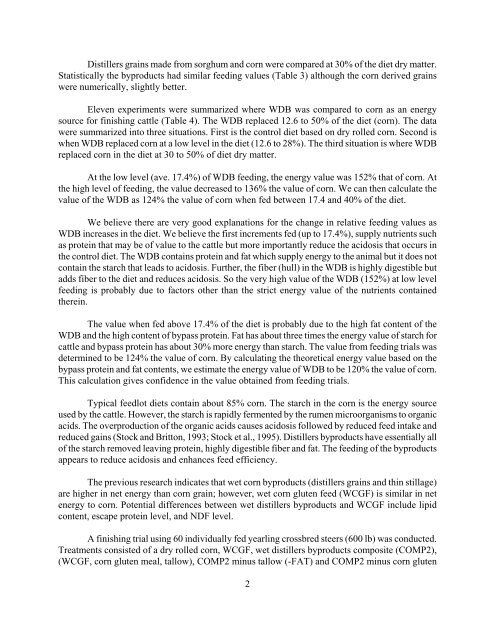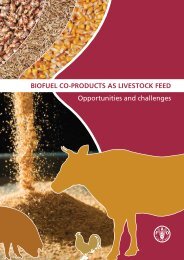Distillers Grains Feeding Recommendations. - Distillers Grains By ...
Distillers Grains Feeding Recommendations. - Distillers Grains By ...
Distillers Grains Feeding Recommendations. - Distillers Grains By ...
Create successful ePaper yourself
Turn your PDF publications into a flip-book with our unique Google optimized e-Paper software.
<strong>Distillers</strong> grains made from sorghum and corn were compared at 30% of the diet dry matter.Statistically the byproducts had similar feeding values (Table 3) although the corn derived grainswere numerically, slightly better.Eleven experiments were summarized where WDB was compared to corn as an energysource for finishing cattle (Table 4). The WDB replaced 12.6 to 50% of the diet (corn). The datawere summarized into three situations. First is the control diet based on dry rolled corn. Second iswhen WDB replaced corn at a low level in the diet (12.6 to 28%). The third situation is where WDBreplaced corn in the diet at 30 to 50% of diet dry matter.At the low level (ave. 17.4%) of WDB feeding, the energy value was 152% that of corn. Atthe high level of feeding, the value decreased to 136% the value of corn. We can then calculate thevalue of the WDB as 124% the value of corn when fed between 17.4 and 40% of the diet.We believe there are very good explanations for the change in relative feeding values asWDB increases in the diet. We believe the first increments fed (up to 17.4%), supply nutrients suchas protein that may be of value to the cattle but more importantly reduce the acidosis that occurs inthe control diet. The WDB contains protein and fat which supply energy to the animal but it does notcontain the starch that leads to acidosis. Further, the fiber (hull) in the WDB is highly digestible butadds fiber to the diet and reduces acidosis. So the very high value of the WDB (152%) at low levelfeeding is probably due to factors other than the strict energy value of the nutrients containedtherein.The value when fed above 17.4% of the diet is probably due to the high fat content of theWDB and the high content of bypass protein. Fat has about three times the energy value of starch forcattle and bypass protein has about 30% more energy than starch. The value from feeding trials wasdetermined to be 124% the value of corn. <strong>By</strong> calculating the theoretical energy value based on thebypass protein and fat contents, we estimate the energy value of WDB to be 120% the value of corn.This calculation gives confidence in the value obtained from feeding trials.Typical feedlot diets contain about 85% corn. The starch in the corn is the energy sourceused by the cattle. However, the starch is rapidly fermented by the rumen microorganisms to organicacids. The overproduction of the organic acids causes acidosis followed by reduced feed intake andreduced gains (Stock and Britton, 1993; Stock et al., 1995). <strong>Distillers</strong> byproducts have essentially allof the starch removed leaving protein, highly digestible fiber and fat. The feeding of the byproductsappears to reduce acidosis and enhances feed efficiency.The previous research indicates that wet corn byproducts (distillers grains and thin stillage)are higher in net energy than corn grain; however, wet corn gluten feed (WCGF) is similar in netenergy to corn. Potential differences between wet distillers byproducts and WCGF include lipidcontent, escape protein level, and NDF level.A finishing trial using 60 individually fed yearling crossbred steers (600 lb) was conducted.Treatments consisted of a dry rolled corn, WCGF, wet distillers byproducts composite (COMP2),(WCGF, corn gluten meal, tallow), COMP2 minus tallow (-FAT) and COMP2 minus corn gluten2
















